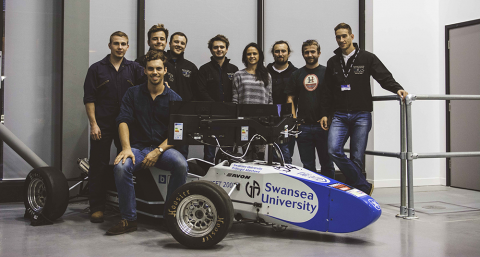Additive manufacturing crosses the finishing line
The aim is to design and build a single-seater car which races on a course normally reserved for Formula 1. Formula Student is also a place where innovation is very much at home, particularly when it comes to new manufacturing methods and design engineering.
For the 2015 Formula Society of Automotive Engineers (FSAE) race, Swansea University worked closely with global engineering company and additive manufacturing expert Renishaw to redesign the intercooler of its race car and manufacture it on a Renishaw AM250 additive manufacturing system.
The history of the FSAE goes back to 1981, when it was first set up in the United States. Over the years, the competition has become more and more popular with the academic and engineering communities around the world. Each year, innovative designs are submitted, often pushing the boundaries of traditional automotive sports.
A place for additive manufacturing
Swansea University Race Engineering is one of the Formula Student teams that has been at the forefront of the competition since 2001, experimenting with new designs and technologies. The team is made up of engineering students from across different disciplines and levels of study, who work alongside experts from the Materials Advanced Characterisation Centre (MACH1) and the ASTUTE project based at Swansea University, and funded by the Welsh Government and Welsh European Funding Office, respectively.
The Swansea University team focuses on developing different aspects of the car, including suspension, engine, chassis and heat transfer. The students' approach to innovation is pragmatic: if you take a car apart, improve each component and then put all the parts back together, the whole will be greater than the sum of the parts.
One of the components that was given a radical make-over this year was the car's intercooler. The aim was to redesign the component to make it lighter and more compact than its old counterpart.
A combination of these factors was expected to improve the car's speed. To achieve the objective, the team looked towards additive manufacturing, more specifically, metal powder bed fusion.
Metal powder bed fusion uses a powerful high precision laser to fuse fine metallic powders in order to form highly complex functional components. The design of the parts is optimised using 3D computer-aided design (CAD) and the components themselves can be built from a wide range of metal powders melted in a tightly controlled inert atmosphere, in layers with a thickness ranging from 20 μm to 100 μm.
"The project wouldn't have been as successful without Renishaw's constant support. Additive manufacturing is a complex process, so it always helps to be able to consult an expert whenever you run into any hurdles. Luckily, Renishaw was never more than a phone call away, so their team helped us in the design, testing and manufacturing stage." - Swansea University (UK)





